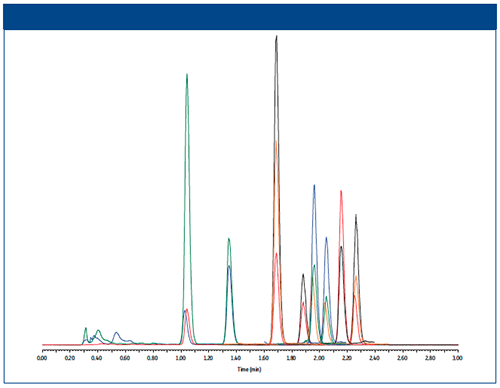Analysis of Fentanyl and Its Analogues in Human Urine by LC–MS/MS
The Application Notebook
Abuse of synthetic opioid prescription painkillers such as fentanyl, along with a rapidly growing list of illicit analogues, is a significant public health problem. In this study, we developed a simple dilute-and-shoot method that provides a fast 3.5-min analysis of fentanyl and related compounds (norfentanyl, acetyl fentanyl, alfentanil, butyryl fentanyl, carfentanil, remifentanil, and sufentanil) in human urine by LC–MS/MS using a Raptor Biphenyl column.
Abuse of synthetic opioid prescription painkillers such as fentanyl, along with a rapidly growing list of illicit analogues, is a significant public health problem. In this study, we developed a simple dilute-and-shoot method that provides a fast 3.5-min analysis of fentanyl and related compounds (norfentanyl, acetyl fentanyl, alfentanil, butyryl fentanyl, carfentanil, remifentanil, and sufentanil) in human urine by LC–MS/MS using a Raptor Biphenyl column.
In recent years, the illicit use of synthetic opioids has skyrocketed, and communities worldwide are now dealing with an ongoing epidemic. Of the thousands of synthetic opioid overdose deaths per year, most are related to fentanyl and its analogues. With their very high analgesic properties, synthetic opioid drugs such as fentanyl, alfentanil, remifentanil, and sufentanil are potent painkillers that have valid medical applications; however, they are also extremely addictive and are targets for abuse. In addition to abuse of these prescription drugs, the current opioid crisis is fueled by a growing number of illicit analogues, such as acetyl fentanyl and butyryl fentanyl, which have been designed specifically to evade prosecution by drug enforcement agencies.
As the number of opioid drugs and deaths increases, so does the need for a fast, accurate method for the simultaneous analysis of fentanyl and its analogues. Therefore, we developed this LC–MS/MS method for measuring fentanyl, six analogues, and one metabolite (norfentanyl) in human urine. A simple diluteâandâshoot sample preparation procedure was coupled with a fast (3.5 min) chromatographic analysis using a Raptor Biphenyl column. This method provides accurate, precise identification and quantitation of fentanyl and related compounds, making it suitable for a variety of testing applications, including clinical toxicology, forensic analysis, workplace drug testing, and pharmaceutical research.
Experimental Conditions
Sample Preparation: The analytes were fortified into pooled human urine. An 80 µL urine aliquot was mixed with 320 µL of 70:30 water–methanol solution (fivefold dilution) and 10 µL of internal standard (40 ng/mL in methanol) in a Thomson SINGLE StEP filter vial (Restek cat. #25895). After filtering through the 0.2 µm PVDF membrane, 5 µL was injected into the LC–MS/MS.
Calibration Standards and Quality Control Samples: The calibration standards were prepared in pooled human urine at 0.05, 0.10, 0.25, 0.50, 1.00, 2.50, 5.00, 10.0, 25.0, and 50.0 ng/mL. Three levels of QC samples (0.75, 4.0, and 20 ng/mL) were prepared in urine for testing accuracy and precision with established calibration standard curves. Recovery analyses were performed on three different days. All standards and QC samples were subjected to the sample preparation procedure described.
LC–MS/MS analysis of fentanyl and its analogues was performed on an ACQUITY UPLC instrument coupled with a Waters Xevo TQ-S mass spectrometer. Instrument conditions were as follows, and analyte transitions are provided in Table 1.

Analytical column: Raptor Biphenyl (5 µm, 50 mm × 2.1 mm; cat. #9309552)
Guard column: Raptor Biphenyl EXP guard column cartridge, (5 µm, 5 mm × 2.1 mm; cat. #930950252)
Mobile phase A: 0.1% Formic acid in water
Mobile phase B: 0.1% Formic acid in methanol
Gradient Time (min) %B
0.00 30
2.50 70
2.51 30
3.50 30
Flow rate: 0.4 mL/min
Injection volume: 5 µL
Column temp.: 40 °C
Ion mode: Positive ESI
Results
Chromatographic Performance: All eight analytes were well separated within a 2.5-min gradient elution (3.5-min total analysis time) on a Raptor Biphenyl column (Figure 1). No significant matrix interference was observed to negatively affect quantification of the fivefold diluted urine samples. The 5-µm particle Raptor Biphenyl column used here is a superficially porous particle (SPP) column. It was selected for this method in part because it provides similar performance to a smaller particle size fully porous particle (FPP) column, but it generates less system back pressure.
Figure 1: The Raptor Biphenyl column effectively separated all target compounds in urine with no observed matrix interferences. Peak elution order: norfentanyl D5, norfentanyl, remifentanil, acetyl fentanyl 13C6, acetyl fentanyl, alfentanil, fentanyl D5, fentanyl, carfentanil D5, carfentanil, butyryl fentanyl, sufentanil D5, sufentanil.

Linearity: Linear responses were obtained for all compounds and the calibration ranges encompassed typical concentration levels monitored for both research and abuse. Using 1/x weighted linear regression (1/x2 for butyryl fentanyl), calibration linearity ranged from 0.05 to 50 ng/mL for fentanyl, alfentanil, acetyl fentanyl, butyryl fentanyl, and sufentanil; from 0.10 to 50 ng/mL for remifentanil; and from 0.25 to 50 ng/mL for norfentanyl and carfentanil. All analytes showed acceptable linearity with r2 values of 0.996 or greater and deviations of <12% (<20% for the lowest concentrated standard).
Accuracy and Precision: Based on three independent experiments conducted on multiple days, method accuracy for the analysis of fentanyl and its analogues was demonstrated by the %recovery values, which were within 10% of the nominal concentration for all compounds at all QC levels. The %RSD range was 0.5–8.3% and 3.4–8.4% for intraday and interday comparisons, respectively, indicating acceptable method precision (Table 2).

Conclusions
A simple dilute-and-shoot method was developed for the quantitative analysis of fentanyl and its analogues in human urine. The analytical method was demonstrated to be fast, rugged, and sensitive with acceptable accuracy and precision for urine sample analysis. The Raptor Biphenyl column is well suited for the analysis of these synthetic opioid compounds and this method can be applied to clinical toxicology, forensic analysis, workplace drug testing, and pharmaceutical research.

Restek Corporation
110 Benner Circle, Bellefonte, Pennsylvania 16823, USA
Tel. 1 (814) 353 1300
Website: www.restek.com










